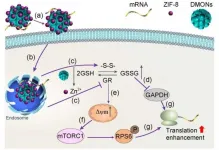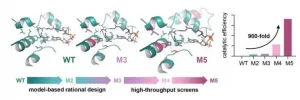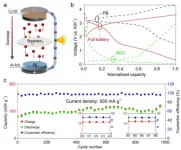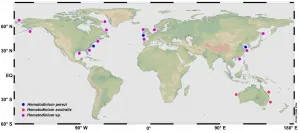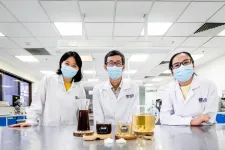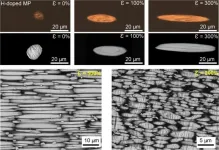A charge-density-wave topological semimetal
A novel material has been discovered that is characterized by the coupling of a charge density wave with the topology of the electronic structure
2021-01-11
(Press-News.org) Topological materials are characterised by unique electronic and physical properties that are determined by the underlying topology of their electronic systems. Scientists from the Max Planck Institutes for Microstructure Physics (Halle) and for Chemical Physics of Solids (Dresden) have now discovered that (TaSe4)2I is the first material in which a charge density wave induces a phase transition between the semimetal to insulator state.
An international team of scientists at the Max Planck Institute for Microstructure Physics, Halle (Saale), the Max Planck Institute for Chemical Physics of Solids in Dresden, Oxford University, Chinese Academy of Sciences, MIT, and Princeton University has discovered the first example of a correlation-driven topological semimetal to insulator phase transition in single crystals of the material (TaSe4)2I. Over the past few years there has been increasing interest in the field of topological materials that display unique electronic and physical properties derived from the underlying topology of their electronic systems. (TaSe4)2I is an unusual material which is known to undergo a structural distortion just below room temperature resulting from a charge density wave. Due to electron correlations the electron gas in the system becomes unstable to a long-range periodic variation of the electron charge density that is intimately coupled to a periodic modulation of the atomic positions in the crystal structure. At the same time this same material has been shown to be a topological metal of a particular type, namely a Weyl semi-metal. This type of topological metal has an electronic system that displays Weyl points where linearly dispersing electronic bands cross one another without forming an energy band gap. These Weyl points in (TaSe4)2I come in pairs, each of which has an opposite chirality, and the authors of the paper show that (TaSe4)2I has 24 pairs of such points with a corresponding enormous so-called chiral charge of +16.
In the study published in the journal Nature Physics, using a set of sophisticated experimental probes of the electronic and crystal structure, the international team, whose members include experimentalists Claudia Felser, Director at the Max Planck Institute for Chemical Physics of Solids , Holger Meyerheim, a researcher, and Stuart Parkin, Director, at the Max Planck Institute for Microstructure Physics, Yulin Chen from Oxford University, and theorist Andrei Bernevig from Princeton University, showed that the topological properties of this compound are intimately connected to the charge density wave, whose wave-vector is derived from the connections between Weyl points of opposite chiral charge.
"It was very challenging, but very exciting, to identify the charge density wave in this material. We needed to use very brilliant x-ray sources available, for example, at the European Synchrotron Radiation Facility, Grenoble, to find the very weak diffraction peak signatures of the charge density wave", Meyerheim pointed out. As the sample is cooled down strong electron correlations drive the system into the charge density wave state resulting in a transition from a topological Weyl semi-metal to an insulator. At the same time, new physics, reported in a previous paper by the same groups, appears below the transition.
"Who would have believed that we would have found such sophisticated correlated electron physics in such a 1D material", remarks Felser. This work shows an intimate connection between topology and correlations and provides an avenue to observing condensed-matter realizations of axion electrodynamics - a novel type of coupling between electric and magnetic fields - in a regime that was previously inaccessible. While this is a first example, "our calculations of the electronic structures of many materials makes us certain that there must be many more such systems where correlations and topology intertwine" remarked Bernevig and "we are excited to look for them in experiments", added Yulin. By manipulating the onset of the charge density wave one can gain direct access to the Topological Weyl Semimetal - Axion Insulator transition. "These materials are a rich playground for potential applications in future electronic devices, a new field of what you might call "topaxtronics!" Stuart Parkin predicts.
INFORMATION:
Original publication
Wujun Shi, Benjamin J. Wieder, Holger L. Meyerheim, Yan Sun, Yang Zhang Yiwei Li, Lei Shen, Yanpeng Qi, Lexian Yang, Jagannath Jena, Peter Werner, Klaus Koepernik, Stuart Parkin, Yulin Chen, Claudia Felser, B. Andrei Bernevig
A charge-density-wave topological semimetal
Nature Physics (2021)
Published 04 January 2021
[Attachments] See images for this press release:
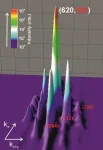
ELSE PRESS RELEASES FROM THIS DATE:
2021-01-11
Delivery of genetic molecules such as mRNA into cells is vital with important applications such as vaccine development. Various agents have been developed for mRNA delivery. However, conventional mRNA nanocarriers mainly focus on their physical interaction with mRNA molecules, or protection / delivery of mRNA, such as adjusting physical properties of nanocarriers to control binding with mRNA or cellular uptake. Moreover, effective mRNA delivery in hard-to-transfect APCs remains a challenge. The hard-to-transfect nature in APCs is partly attributed to the suppressed mRNA translation associated with the intrinsic high intracellular glutathione (GSH) level. Thus, ...
2021-01-11
Photorespiration is a highly energy consuming process in plants that leads to the release of previously fixed CO2. Thus, engineering this metabolic process is a key approach for improvement of crop yield and for meeting the challenge of ever-rising CO2 levels in the atmosphere. Researchers led by Tobias Erb from the Max Planck Institute for Terrestrial Microbiology in Marburg, Germany, have now succeeded in engineering the TaCo pathway, a synthetic photorespiratory bypass. This new-to-nature metabolic connection opens up new possibilities of CO2 fixation ...
2021-01-11
With the rapid development of smart portable electronics and electric vehicles, the consumption of lithium resource will increase dramatically and the cost of lithium-ion batteries (LIBs) may increase significantly in the future. In addition, the shortage (0.0017 wt% in the earth's crust) and uneven crustal distribution of lithium also limit its further development and application. As potassium (2.7 wt% in the earth's crust) have properties similar to lithium and abundant reserves. Therefore, as an alternative to LIBs, potassium ion batteries (PIBs) have become the focus of research. Potassium (2.92 V vs. ...
2021-01-11
Scientists from the Max Planck Institute of Psychiatry, led by Nikolaos Koutsouleris, combined psychiatric assessments with machine-learning models that analyse clinical and biological data. Although psychiatrists make very accurate predictions about positive disease outcomes, they might underestimate the frequency of adverse cases that lead to relapses. The algorithmic pattern recognition helps physicians to better predict the course of disease.
The results of the study show that it is the combination of artificial and human intelligence that optimizes the prediction ...
2021-01-11
The spiky structure that erupts from the smooth surface of a ferrofluid when a magnet is brought close can be predicted more accurately than previously thought. KAUST researchers have shown that computational algorithms can calculate the ferrofluid's bristling response to a magnet by simulating only the liquid's surface layer.
Ferrofluids are liquid suspensions of iron-based particles that behave like a regular fluid, but once a magnet is present, the ferrofluid rapidly shape-shifts to form spikes that align with the magnetic field. Originally developed by NASA, ferrofluids have numerous uses ranging from advanced electronics to nanomedicine and have the potential for even broader use, if their magnetic responses could be predicted more accurately.
Dominik Michels and ...
2021-01-11
Co-culture: stimulate the metabolic potential and explore the molecular diversity of natural products from microorganisms
Announcing a new publication for Marine Life Science & Technology journal. In this review article the authors Xiao-Yue Peng, Jin-Tao Wu, Chang?Lun Shao, Zhi-Yong Li, Min Chen and Chang-Yun Wang from the Ocean University of China, Qingdao, China, Yangzhou University, Yangzhou, China, Qingdao National Laboratory for Marine Science and Technology, Qingdao, China and Shanghai Jiao Tong University, Shanghai, China consider the metabolic potential and molecular diversity of natural products from microorganisms.
Microbial secondary metabolites have long ...
2021-01-11
Announcing a new publication for Marine Life Science & Technology journal. In this review article the authors Caiwen Li, Meng Li and Qian Huang from Institute of Oceanology, Chinese Academy of Sciences, Qingdao, China consider the impact of the parasitic dinoflagellate Hematodinium on aquaculture of marine crustaceans in China.
Hematodinium is a type of parasitic dinoflagellate that infects marine crustaceans globally. The parasite lives mainly in the hemolymph or hemocoels of affected hosts, and results in mortalities due to malfunction or loss of functions of major organs.
In recent years, the parasite has developed into an emerging epidemic pathogen not only affecting wild populations of economically valuable marine crustaceans ...
2021-01-11
Good news for those who need a cuppa to start the day. Researchers from the National University of Singapore (NUS) have created new probiotic coffee and tea drinks that are packed with gut-friendly live probiotics.
Supervised by Associate Professor Liu Shao Quan from the Department of Food Science and Technology at the NUS Faculty of Science, the two doctoral students who worked on these two new beverages assert that their drinks have a great taste, and can be stored chilled or at room temperature for more than 14 weeks without compromising on their probiotic viability.
Traditional probiotic carriers like yoghurts and cultured milks are dairy-based products. The rise in veganism, along with common health issues like lactose intolerance, high ...
2021-01-11
Today's electronic devices strive for new form factors - to make them foldable, stretchable, and deformable. To produce such devices that are highly stretchable or deformable, it is necessary to develop electrodes and circuit lines whose electrical properties can withstand harsh deformation or mechanical damage. To this, POSTECH-Yonsei University joint research team has recently developed liquid metal ink to accelerate printed electronic devices that can be changed into any shape.
Professor Unyong Jeong and Dr. Selvaraj Veerapandian of POSTECH's Department of Materials Science and Engineering, with Professor Aloysius Soon and Dr. Woosun Jang of Yonsei University's Department of Materials Science and Engineering, have developed liquid metal microparticles ...
2021-01-11
NIH-supported pilot study found team-based approach may improve buprenorphine care.
WHAT:
A collaborative approach to treating opioid use disorder that relies heavily on community pharmacists is feasible and may increase adherence and participant satisfaction, according to a pilot study published today in Addiction. The study was supported by the National Institute on Drug Abuse (NIDA), part of the National Institutes of Health, through the NIDA Center for the Clinical Trials Network.
Most people with opioid use disorder who would benefit from medication do not receive it. Buprenorphine is a safe and effective ...
LAST 30 PRESS RELEASES:
[Press-News.org] A charge-density-wave topological semimetal
A novel material has been discovered that is characterized by the coupling of a charge density wave with the topology of the electronic structure

